This guide will teach you how to make violets out of beads and wire.
You will need:
- seed beads #11:
blue - 30 grams,
green - 50 grams,
yellow - 1 gram,
- wire 0.3 mm in diameter, preferably of a dark color.
We should make flowers out of blue beads first.
Take a wire of 70 cm in length and string 4 beads onto it. Place the beads on the wire so that one end of the wire should be 10-15 cm in length.
Fold the wire to make a loop of beads and twist the wires.
String 11 beads onto the long wire.
Fold the second loop above the first arc and twist the wires.
For the third loop string 20 beads onto the long wire.
A tip: because the beads may vary slightly in size, it may be necessary to take 21 or even 22 beads so that the resulting loop should be completely filled with beads.
Twist the wires - one petal of the flower is ready.
Then on the same wire we should make 4 more such petals. String 4 beads onto the long wire.
Twist these 4 beads into a loop about 7 mm away from the first petal.
For the second loop string 11 beads and twist the wire.
For the third loop string 20 beads. Twist the wire - the second petal is ready.
Repeat the same process 3 more times to make 3 more petals. Now we've got a flower.
Note that each subsequent petal slightly overlaps the previous one so that as soon as we've made the 5th petal it is not necessary to twist the whole flower.
We need to make 9 such flowers.
Then we should make pistils out of yellow beads.
Take a wire of 20 cm in length and string 4 beads onto it. Place the beads on the middle of the wire.
Fold the beads into a loop and twist the wires.
Fold together both ends of the wire and string 2 beads on them.
Bend the wire as it is shown on the photo (a set of beads looks like a mushroom).
The pistil is completed. We need to make 9 such pistils (the same quantity as the number of flowers).
Now we begin to weave the violets' leaves. We make them out of green beads.
First we make the smallest leaves. Take a wire of 60 cm in length and make a loop on it so that one end of the wire, coming out of the loop should be about 5 cm in length.
String 8 beads onto the short wire and 10 beads onto a long wire.
Fold both ends of the wire parallel to each other and twist them together so that the beads onto the long wire form a small arc above the beads onto the short wire.
Slightly compress the rows of beads so that they lay close to each other.
All the other beads string only on the long wire. First, string 10 beads.
Fasten them so that they form an arc opposite to the previous 10 beads. The row of 8 beads is situated in the middle of the leaf. Thus we've got the first circle of 10 + 10 beads.
The second circle also consists of two halves, for each of which we take 16 beads.
A tip: the leaf will look nicer if you fasten each new row of beads for just one turn of wire (the more number of turns in the twisting, the worse the finished leaf will look).
The third circle consists of two halves, for each of which we take 19 beads.
Making of the leaf is completed. Bend the short wire inward the leaf and cut it off. Twist the long wire along with the original loop.
For our convenience, we assume that we made this leaf using the following formula:
the middle - 8 beads,
the first circle - 10+10 beads,
the second circle - 16+16 beads,
the third circle - 19+19 beads.
We need to make 3 such small leaves.
Next, we make the remaining leaves. They all are weaved like a small leaf, we just need to take a longer wire - of 100 cm in length for each.
First, we make leaves consisting of four circles, using the following formula:
the middle - 10 beads,
the first circle - 14+14 beads,
the second circle - 19+19 beads,
the third circle - 24+24 beads,
the fourth circle - 29+29 beads.
As I have already mentioned, since the beads may vary slightly in size, perhaps, the actual number of beads will also differ from the indicated number - it's not bad. Take as many beads, as you need to make a nice leaf.
We need to make 5 such leaves.
Next, we make leaves consisting of five circles, using the following formula:
the middle - 12 beads,
the first circle - 15+15 beads,
the second circle - 21+21 beads,
the third circle - 26+26 beads,
the fourth circle - 33+33 beads,
the fifth circle - 38+38 beads.
We need to make 4 such leaves.
The remaining leaves consist of six circles:
the middle - 12 beads,
the first circle - 15+15 beads,
the second circle - 21+21 beads,
the third circle - 26+26 beads,
the fourth circle - 33+33 beads,
the fifth circle - 38+38 beads,
the sixth circle - 44+44 beads.
We need to make 4 such leaves.
Weaving is completed. Now let's assemble the violets.
Take the pistil and insert it into the middle of the flower.
Pull the pistil's wire and twist it together with the flower's wire.
Do the same with the other eight flowers.
Next, take three flowers and twist them together retaining for the each flower an untwisted wire of approximately 5 cm in length.
Do the same with the remaining flowers. Now we've got 3 sprigs of 3 flowers in each.
Take all these sprigs and twist them together. As a result we've got a bush of flowers.
Then take the smallest leaves and twist them together retaining for the each leaf an untwisted wire of approximately 5 cm in length.
Fasten the resulting sprig of leaves to the flowers, straightening the leaves to the different sides.
Next, consequentially twists together and attach to the flower the following series of leaves. The greater the size of the leaves is, the more below these leaves should be attached to the flower.
To keep the twisted wires from dispersal, you can bind them together by an additional piece of wire, wrapping it around the stem of the flower.
Now trim the wires and straighten the flowers and leaves.
Violets are ready! You can put the flowers into a pot or a basket, as I did.
P.S. Don't want to miss new tutorials? Subscribe for email notifications of site updates!
If you like this tutorial, share it with your friends on social networks using the buttons below the post.


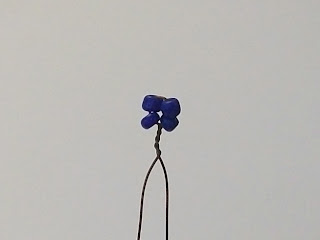



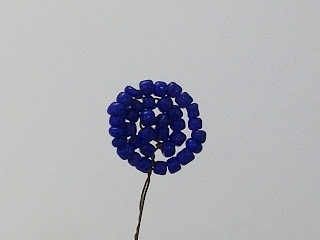
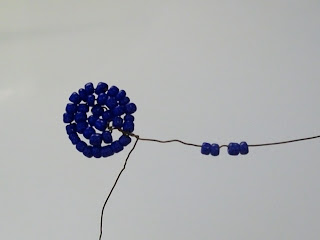




















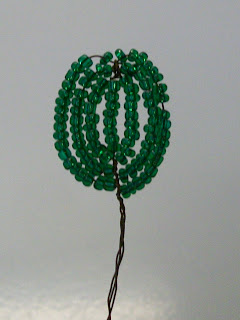



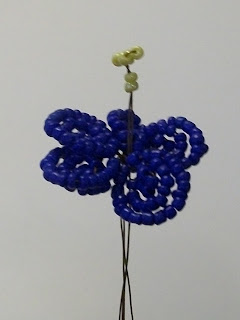












Hi, In the step for the beginning of the leaves, how large should that first (empty) loop be? Thanks.
ReplyDeleteDear Dorothy,
DeleteThat loop is not involved in the beading process, so its size doesn’t matter much. I think, 4 cm long would be enough. If your wire is long, you may make a larger loop.